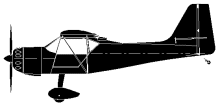
ASN Wikibase Occurrence # 210639
This information is added by users of ASN. Neither ASN nor the Flight Safety Foundation are responsible for the completeness or correctness of this information.
If you feel this information is incomplete or incorrect, you can submit corrected information.
| Date: | Friday 1 August 1997 |
| Time: | 13:48 |
| Type: |  Skyfox CA25N |
| Owner/operator: | |
| Registration: | VH-IDB |
| MSN: | CA25N062 |
| Fatalities: | Fatalities: 0 / Occupants: 1 |
| Aircraft damage: | Substantial |
| Location: | Bishopsbourne, TAS -
 Australia Australia
|
| Phase: | Landing |
| Nature: | Training |
| Departure airport: | YMLT |
| YMLT | |
| Investigating agency: | BASI |
| Confidence Rating: |
The pilot reported that he was conducting a practice forced landing when the engine stopped. At 3,000 ft he had applied full carburettor heat, closed the throttle and commenced a glide descent. During the descent he applied power on four occasions to re-warm the engine. At about 600 ft AGL the engine stopped along with the geared wooden propeller. The pilot carried out trouble checks and declared a Mayday. He twice engaged the starter in an attempt to restart the engine but was unsuccessful. He subsequently reported that the starter seemed to be sluggish. The aircraft touched down in a paddock on a downhill slope. It rolled about 30 metres, crashed through a farm fence, passed under a powerline, crossed a road, encountered a ditch and overturned. At the time of the accident weather conditions were: CAVOK, outside temperature about 15 degrees Celsius, wind calm, visibility 10 km plus, nil precipitation. This was the second accident to VH-IDB in the same area due to the engine stopping during practice forced landings. The previous accident occurred on 14 May 1997. Verbal reports of other instances have been received of Skyfox Gazelles experiencing engine stoppages after the throttle was closed and engine RPM reduced to idle. After the first accident, the engine was inspected by a licensed aircraft maintenance engineer (LAME). Then, after the second accident with the same engine installed, it was inspected first by the LAME and then by the engine manufacturer's agent. No fault was found with the engine after each accident. Post accident tests on the starter, the battery and the engine have failed to detect a reason for the sluggish starter anomaly reported by the pilot. Safety Action As a result of complaints about the stalling of engines at idle, Airworthiness officers from the Civil Aviation Safety Authority (CASA), in conjunction with the aircraft manufacturer, conducted an investigation which included test flights in the Gazelle. It was found that the throttle mechanism had enough free play (also known as backlash) to reduce RPM below idle and stop the engine. This could occur if extra force was applied when pulling the throttle back to idle speed. To address this problem, the aircraft manufacturer issued Service Bulletin (SB) No. 20 on 28 October 1997. This SB provides the following information: "Idle speed may inadvertently be reduced below set minimum due to incorrect throttle stop adjustment." SB 20 requires operators to check the idle setting and adjust for backlash at the throttle stop in the cockpit. Compliance was mandatory, within two weeks or 10 hours time in service from receipt of the SB.
Accident investigation:
 |
|
Sources:
https://www.atsb.gov.au/publications/investigation_reports/1997/aair/199702530/
https://www.atsb.gov.au/media/4931003/199702530.pdf
Revision history:
| Date/time | Contributor | Updates |
|---|---|---|
| 08-May-2018 15:31 | Pineapple | Added |
Corrections or additions? ... Edit this accident description
The Aviation Safety Network is an exclusive service provided by:


 ©2024 Flight Safety Foundation
©2024 Flight Safety Foundation